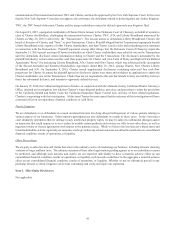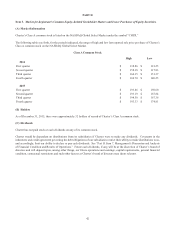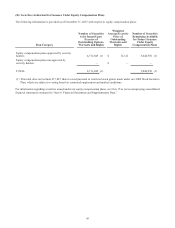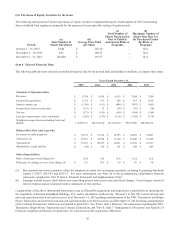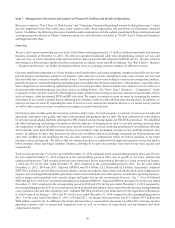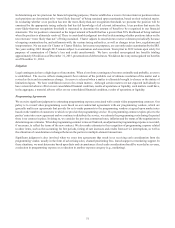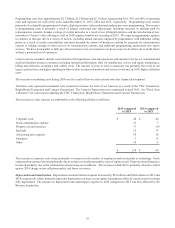Charter 2015 Annual Report Download - page 63
Download and view the complete annual report
Please find page 63 of the 2015 Charter annual report below. You can navigate through the pages in the report by either clicking on the pages listed below, or by using the keyword search tool below to find specific information within the annual report.48
In addition, there are other items within our financial statements that require estimates or judgment that are not deemed critical,
such as the allowance for doubtful accounts and valuations of our derivative instruments, but changes in estimates or judgment
in these other items could also have a material impact on our financial statements.
Property, plant and equipment
The cable industry is capital intensive, and a large portion of our resources are spent on capital activities associated with extending,
rebuilding, and upgrading our cable network. As of December 31, 2015 and 2014, the net carrying amount of our property, plant
and equipment (consisting primarily of cable network assets) was approximately $8.3 billion (representing 49% of total assets
excluding restricted cash and cash equivalents) and $8.4 billion (representing 48% of total assets excluding restricted cash and
cash equivalents), respectively. Total capital expenditures for the years ended December 31, 2015, 2014 and 2013 were
approximately $1.8 billion, $2.2 billion and $1.8 billion, respectively.
Capitalization of labor and overhead costs. Costs associated with network construction, initial customer installations, installation
refurbishments, and the installation of equipment necessary to provide video, Internet or voices services, are capitalized. While
our capitalization is based on specific activities, once capitalized, we track these costs by fixed asset category at the cable system
level, and not on a specific asset basis. For assets that are sold or retired, we remove the estimated applicable cost and accumulated
depreciation. Costs capitalized as part of installations include materials, direct labor, and certain indirect costs. These indirect
costs are associated with the activities of personnel who assist in installation activities, and consist of compensation and overhead
costs associated with these support functions. The costs of disconnecting service at a customer’s dwelling or reconnecting service
to a previously installed dwelling are charged to operating expense in the period incurred. Costs for repairs and maintenance are
charged to operating expense as incurred, while plant and equipment replacement, including replacement of certain components,
and betterments, including replacement of cable drops from the pole to the dwelling, are capitalized.
We make judgments regarding the installation and construction activities to be capitalized. We capitalize direct labor and overhead
using standards developed from actual costs and applicable operational data. We calculate standards annually (or more frequently
if circumstances dictate) for items such as the labor rates, overhead rates, and the actual amount of time required to perform a
capitalizable activity. For example, the standard amounts of time required to perform capitalizable activities are based on studies
of the time required to perform such activities. Overhead rates are established based on an analysis of the nature of costs incurred
in support of capitalizable activities, and a determination of the portion of costs that is directly attributable to capitalizable activities.
The impact of changes that resulted from these studies were not material in the periods presented.
Labor costs directly associated with capital projects are capitalized. Capitalizable activities performed in connection with
installations include such activities as:
• dispatching a “truck roll” to the customer’s dwelling or business for service connection or placement of equipment;
• verification of serviceability to the customer’s dwelling or business (i.e., determining whether the customer’s dwelling
is capable of receiving service by our cable network and/or receiving advanced or Internet services);
• customer premise activities performed by in-house field technicians and third-party contractors in connection with
customer installations, installation of equipment in connection with the installation of video, Internet or voice services,
and equipment replacement and betterment; and
• verifying the integrity of the customer’s network connection by initiating test signals downstream from the headend
to the customer’s digital set-top box, as well as testing signal levels at the pole or pedestal.
Judgment is required to determine the extent to which overhead costs incurred result from specific capital activities, and therefore
should be capitalized. The primary costs that are included in the determination of the overhead rate are (i) employee benefits and
payroll taxes associated with capitalized direct labor, (ii) direct variable costs associated with capitalizable activities, consisting
primarily of installation and construction vehicle costs, (iii) the cost of support personnel, such as dispatchers, who directly assist
with capitalizable installation activities, and (iv) indirect costs directly attributable to capitalizable activities.
While we believe our existing capitalization policies are appropriate, a significant change in the nature or extent of our system
activities could affect management’s judgment about the extent to which we should capitalize direct labor or overhead in the future.
We monitor the appropriateness of our capitalization policies, and perform updates to our internal studies on an ongoing basis to
determine whether facts or circumstances warrant a change to our capitalization policies. We capitalized internal direct labor and
overhead of $286 million, $277 million and $219 million, respectively, for the years ended December 31, 2015, 2014 and 2013.
Valuation and impairment. We evaluate the recoverability of our property, plant and equipment upon the occurrence of events
or changes in circumstances indicating that the carrying amount of an asset may not be recoverable. Such events or changes in
circumstances could include such factors as the impairment of our indefinite life franchises, changes in technological advances,





